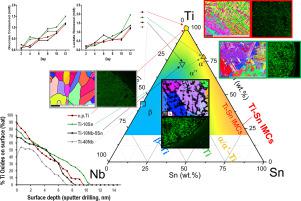Biomaterials Advances ( IF 5.5 ) Pub Date : 2020-03-12 , DOI: 10.1016/j.msec.2020.110839 C Torres-Sánchez 1 , J Wang 1 , M Norrito 1 , L Zani 1 , P P Conway 1

|
Titanium (Ti) alloys with Niobium (Nb) and Tin (Sn) were prepared in order to conduct a systematic study on the bulk and surface properties of as-cast c.p.Ti, binary Ti-40Nb and Ti-10Sn, and ternary Ti-10Nb-5Sn (at.%) to ascertain whether Sn content can be used as an enhancer for cell activity. From a metallurgy viewpoint, a range of binary and ternary alloys displaying distinctive Ti phases (i.e. β, α’, α”) were achieved at room temperature. Their surface (oxide thickness and composition, roughness, contact angle) and bulk (compressive stiffness, strength, elongation, microhardness, electrical resistance) features were characterised. The same surface roughness was imparted on all the alloys, therefore substrate-cell interactions were evaluated independently from this variable. The physico-mechanical properties of the ternary alloy presented the highest strength to stiffness ratio and thereby proved the most suitable for load-bearing orthopaedic applications. From a cellular response viewpoint, their cytotoxicity, ability to adsorb proteins, to support cell growth and to promote proliferation were studied. Metabolic activity using a mouse model was monitored for a period of 12 days to elucidate the mechanism behind an enhanced proliferation rate observed in the Sn-containing alloys. It was hypothesised that the complex passivating surface oxide layer and the bulk inhomogeneity with two dominant Ti phases were responsible for this phenomenon.
中文翻译:

将锡添加到TiNb合金中可改善机械性能和表面性能,从而有助于增强细胞活性。
为了对铸态cpTi,二元Ti-40Nb和Ti-10Sn以及三元Ti-10Nb的体积和表面性能进行系统研究,制备了含铌(Nb)和锡(Sn)的钛(Ti)合金。 -5Sn(at。%)以确定Sn含量是否可用作细胞活性的增强剂。从冶金学的角度来看,在室温下可获得一系列显示出独特的Ti相(即β,α',α”)的二元和三元合金。表征了它们的表面(氧化物厚度和组成,粗糙度,接触角)和体积(压缩刚度,强度,伸长率,显微硬度,电阻)的特征。所有合金均具有相同的表面粗糙度,因此独立于该变量评估了基材与电池之间的相互作用。三元合金的物理机械性能表现出最高的强度刚度比,因此被证明最适合承重的骨科应用。从细胞反应的角度,研究了它们的细胞毒性,吸附蛋白质的能力,支持细胞生长和促进增殖的能力。使用小鼠模型监测代谢活性达12天,以阐明在含Sn合金中观察到增殖速率提高的机制。假设该现象是由复杂的钝化表面氧化物层和具有两个主要的Ti相的整体不均匀性引起的。研究了吸附蛋白质,支持细胞生长和促进增殖的能力。使用小鼠模型监测代谢活性达12天,以阐明在含Sn合金中观察到增殖速率提高的机制。假设该现象是由复杂的钝化表面氧化物层和具有两个主要的Ti相的整体不均匀性引起的。研究了吸附蛋白质,支持细胞生长和促进增殖的能力。使用小鼠模型监测代谢活性达12天,以阐明在含Sn合金中观察到增殖速率提高的机制。假设该现象是由复杂的钝化表面氧化物层和具有两个主要的Ti相的整体不均匀性引起的。

















































 京公网安备 11010802027423号
京公网安备 11010802027423号